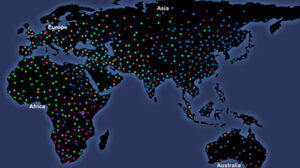
Credit: Science Museum of Minnesota, based on the work of Dr. Kenneth Kidd
According to current research, the African continent is the ancestral home of modern humans. Scientists studying patterns il human genetic variation have observed the greatest amount of human genetic diversity in African populations. Genetic variation outside of Africa-in Europe and Asia-includes some, but not all, of the genetic variation found in Africa, which suggests that between 140,000 and 290,000 years ago, Homo sapiens migrated out of Africa to colonize Europe, Asia and the Americas. This “Out of Africa” theory is supported by studies of mtDNA, the Y chromosomeLong strands of DNA found inside the cell nucleus. Human cells each contain 23 pairs... More, portions of the X chromosome, and some but not all autosomal (non-sex determining) regions, as well as the archaeological record.
- In 1953, James D. Watson and Frances Crick discovered the double helixthe DNA looks like a long twisted ladder. The sides of the ladders are composed... More structure of DNA.
- In 1956, Jo Hin Tjio and Albert Levan determined that there are 46 human chromosomes.
- In 1966, Marshall Niremberg, Heinrich Mathaei and Severo Ochoa cracked the human genetic code, opening the door for the explosion of genetic engineering studies and achievements beginning in the late 1970s. The genetic code is the set of rules by which information encoded in genetic material (DNA or RNA sequences) is translated into proteins (amino acid sequences) by living cells.
- In 1972, scientists Stanley Cohen and Herbert Boyer developed recombinant DNA (DNA) technology, an artificial DNA sequencing process that that “recombines” the DNA of two different organisms.
- In 1977, molecular geneticists Walter Gilbert and Allan Maxam pioneered a ne DNA sequencing method.
- In 1981, population geneticist Luigi Luca Cavalli-Sforza established the dual inheritance theory with Marcus Feldman which suggests that human variation is the result of both biological and cultural evolutionthe transformation of a species of organic life over long periods of time (macroevolution) or... More.
- In 1983, scientists successfully mapped the first human disease gene-the aene for Huntinaton’s disease-with DNA markers.
- In 1989, Francis Collins and Lap-Chee Tsui sequenced the first human genea unique combination of bases (see base pairs) that creates a specific part of our... More. It encoded the CFTR protein, the defective gene that causes cystic fibrosis.
- In 2001, the Human Genome Projectan international research effort to sequence and map the human genome, all of the genes... More and Celera Genomics released the first draft sequences of the human genomeone complete copy of all the genes and DNA for a species. More.
- The Human Genome Project was successfully completed with 99% of the human genome sequenced to within 99.99% accuracy.

Credit: National Institutes of Health
“The classification into races has proved to be a futile exercise.”
– Luigi Luca Cavalli-Sforza
One of the important geneticists of the 20th century, Stanford’s Italian-born population geneticist Luigi Luca Cavalli-Sforza summarized his work in Genes, Peoples, and Languages, which challenged the concept of classifying human populations into races in the same way that birds and other species are classified. Cavalli-Sforza was one of the first to suggest that the genetic history of the human species might be viewed by examining the genetic variation present in modern populations.




